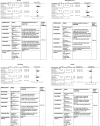The effect of the APOE4 genotype on physiological and cognitive health in randomised controlled trials with an exercise intervention: a systematic review and meta-analysis
- PMID: 39828710
- PMCID: PMC11744846
- DOI: 10.1186/s13063-024-08696-4
The effect of the APOE4 genotype on physiological and cognitive health in randomised controlled trials with an exercise intervention: a systematic review and meta-analysis
Abstract
Background: Alzheimer's disease is caused by modifiable and non-modifiable risk factors. Randomised controlled trials have investigated whether the strongest genetic risk factor for Alzheimer's disease, APOE4, impacts the effectiveness of exercise on health. Systematic reviews are yet to evaluate the effect of exercise on physical and cognitive outcomes in APOE genotyped participants. A quality assessment of these randomised controlled trials is needed to understand the impact genotype has on the potential success of intervention. This systematic review aimed to determine if the APOE4 genotype influences the effectiveness of exercise-based randomised controlled trials.
Method: Searches on MEDLINE, EMBASE, and PsycINFO identified eligible exercise based randomised controlled trials incorporating participants with varied cognitive abilities. Quality assessments were conducted.
Results: Nineteen studies met the inclusion criteria for systematic review, and 3 for the meta-analysis. Very low to moderate quality evidence showed that APOE4 carriers benefitted more than APOE4 non-carriers on cognitive (e.g. executive function, learning) and physical (e.g. relative telomere length) outcomes after exercise; and that APOE4 non-carriers benefited over carriers for physical (serum BDNF, gait speed) and cognitive (global cognition, verbal memory) markers. Very low quality evidence indicated that there was no evidence of difference between APOE4 carriers and non-carriers on physical function outcomes in meta-analysis. Several areas of study design and reporting, including maintenance of relative exercise intensity and complete statistical reporting, were identified as needing improvement.
Discussion: This systematic review found very limited evidence to suggest that exercise interventions can benefit APOE4 carriers and non-carriers equally, though conclusions were limited by evidence quality. Further randomised controlled trials, stratifying participants by APOE status are required to better understand the relationship between APOE genotype and the effect of exercise on health-related outcomes.
Trial registration: This review was registered with PROSPERO (CRD42023436842). Registered on June 16, 2023.
Keywords: Alzheimer’s disease; Exercise; Randomised controlled trials.
© 2025. The Author(s).
Conflict of interest statement
Declarations. Ethics approval and consent to participate: Not applicable. Consent for publication: Not applicable. Competing interests: The authors declare that the research was conducted in the absence of any commercial or financial relationships that could be construed as a potential conflict of interest.
Figures


Similar articles
-
Folic acid supplementation and malaria susceptibility and severity among people taking antifolate antimalarial drugs in endemic areas.Cochrane Database Syst Rev. 2022 Feb 1;2(2022):CD014217. doi: 10.1002/14651858.CD014217. Cochrane Database Syst Rev. 2022. PMID: 36321557 Free PMC article.
-
Effect of Apolipoprotein E4 on the Driving Behavior of Patients with Amnestic Mild Cognitive Impairment or Mild Alzheimer's Disease Dementia.J Alzheimers Dis. 2021;84(3):1005-1014. doi: 10.3233/JAD-210622. J Alzheimers Dis. 2021. PMID: 34602476
-
In Thai Nationals, the ApoE4 Allele Affects Multiple Domains of Neuropsychological, Biobehavioral, and Social Functioning Thereby Contributing to Alzheimer's Disorder, while the ApoE3 Allele Protects Against Neuropsychiatric Symptoms and Psychosocial Deficits.Mol Neurobiol. 2018 Aug;55(8):6449-6462. doi: 10.1007/s12035-017-0848-0. Epub 2018 Jan 6. Mol Neurobiol. 2018. PMID: 29307083
-
The effect of physical activity on cognition relative to APOE genotype (PAAD-2): study protocol for a phase II randomized control trial.BMC Neurol. 2020 Jun 6;20(1):231. doi: 10.1186/s12883-020-01732-1. BMC Neurol. 2020. PMID: 32503473 Free PMC article. Clinical Trial.
-
Behavioural modification interventions for medically unexplained symptoms in primary care: systematic reviews and economic evaluation.Health Technol Assess. 2020 Sep;24(46):1-490. doi: 10.3310/hta24460. Health Technol Assess. 2020. PMID: 32975190 Free PMC article.
References
-
- World Health Organisation. Dementia. 2023, March 15 [cited 2023, July 14]. Available from: https://www.who.int/news-room/fact-sheets/detail/dementia.
-
- Cass SP. Alzheimer’s disease and exercise: a literature review. Curr Sports Med Rep. 2017;16(1):19–22. - PubMed
-
- World Health Organisation. Global Status Report on Physical Activity 2022. 2022 [cited 2023, July 14]. Available from: https://www.who.int/teams/health-promotion/physical-activity/global-stat....
Publication types
MeSH terms
Substances
Grants and funding
LinkOut - more resources
Full Text Sources
Medical
Miscellaneous

